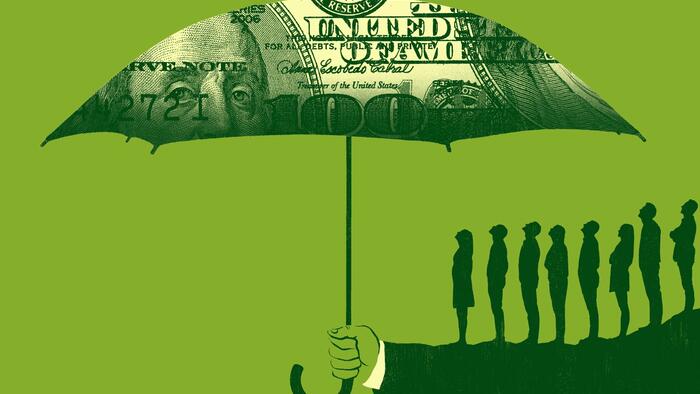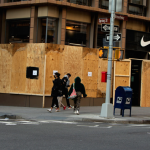Authored by Yves Smith via NakedCapitalism.com,
Typically, financial crises, as in the sort that might or actually do impair the banking system, are the result of leveraged speculation. Is this one of those rare instances when this time might actually be different, via rising wealth inequality creating new levels of hot money that can slosh in and out of banks, making many of them fundamentally less stable?
Now admittedly, the continued rise in wealth inequality is an effect of sustained low central bank interest rates, which goosed asset prices generally and particularly favored speculative plays as investors reached for returns. A great deal of commentary has correctly focused on the effects of deflating these asset bubbles and how the rollback of paper wealth can be particularly harmful to financial firms that wrongfooted the correction.
But the reduction in wealth also produces a system wide reduction in liquidity (mind you, we’ve always thought liquidity is not the virtue that investment touts make it out to be; the world got by just fine in the stone ages with less that instantaneous trading times and higher transaction costs). The effect in a regime, where for better or worse, there are (or have been) lots of big fish with tons of cash who are accustomed to moving it quickly would wind up looking like an emerging market, where US interest rate moves wind up producing huge and destabilizing waves of hot money moving in and out. It appears not to have occurred to the authorities that we were restructuring our financial system so as to make it possible to generate banana-republic levels of upheaval.
The Great Crash blew back to the banking system because stock buyers were making heavy use of margin loans, and on top of that, stock operators were creating leveraged structures (trusts of trusts of trusts). By contrast, the 1987 crash, the result of leveraged buyouts producing a stock market bubble, didn’t do lasting damage, and neither did the later leveraged buyout collapse and large-scale workouts o LBO loans (a big reason is that the loans were syndicated and big foreign banks were big buyers but they didn’t eat enough of this bad US cooking to get really sick). But the Japanese financial crisis was the result of a dual commercial real estate and stock market crash, together on a scale that has stalled Japanese growth for decades. The 2008 crisis looks like a housing crisis, but the severity of the damage resulted from credit default swaps creating synthetic subprime debt that was four to six times real economy exposures.
This is a long-winded way of saying that herd behavior in bad lending and/or leveraged speculation produced enough in the way of actual or soon to be realized losses to damage a lot of banks. And banks are interconnected: if one bank gets in trouble, its depositors are the customers or employers of customers of other banks. If those linked customers of other banks have an unexpected hit to income, they could default on their debt payments, propagating damage across the system.
The crisis of the past week was not that. Three different banks with very different business strategies and asset mixes got in trouble at the same time. Some like Barney Frank, on the board of Signature Bank, argue that the common element was a regulatory crackdown on banks too cozy with the crypto industry. But that’s not really the case with Silicon Valley Bank, which has been suffering for a while from declines in its deposits due to a falloff in new funding all across tech land, as well as more difficult business conditions leading to not much in the way of new customers and falling deposit balances at most existing customers.
What the three banks did have in common was a very high level of uninsured deposits which made them particularly vulnerable to runs and therefore should have led the banks’ managements to be very mindful of asset-liability mismatches and liquidity. And they should have focused on fees rather than the balance sheet to achieve better than ho-hum profits.
Silicon Valley Bank has attempted to wrap itself in the mantle of being a stalwart of those rent-extracting innovative tech companies. But Silicon Valley Bank is hiding behind the skirts of venture capital firms. They are the ones who provided and then kept organizing the influx of capital to these companies. The story of the life of a venture capital backed business is multiple rounds of equity funding. Borrowing is very rarely a significant source of capital. So the idea that Silicon Valley Bank was a lender to portfolio companies is greatly exaggerated.2
Both the press and several readers have confirmed that the reason for Silicon Valley Bank’s lock on the banking business of venture-capital-funded companies was that the VCs required that the companies keep their deposits there. And that’s because the VCs could keep much tighter tabs on their investee companies by having the bank monitor fund in and outflows on a more active basis than the VCs could via periodic management and financial reports.
Now what flows from that? One of the basic rules of business is that it is vastly cheaper to keep customers than find them. Silicon Valley Bank would be highly motivated to attract and retain both the fund and the personal business of its venture capital kingpins. Accordingly, the press has pointed out that loans to vineyards and venture capital honchos’ mortgages were important businesses. It’s not hard to think that these were done on preferential terms to members of a big VC firm’s “family” as a loyalty bonus of sorts.
On top of that, recall that Silicon Valley Bank bought Boston Private with over $10 billion in assets, in July 2021. The wealth management firm also had a very strong registered investment adviser platform and additional assets under management. That suggests Silicon Valley recognized increasingly that the care and feeding of its rich individual clients was core to its strategy.
It’s impossible to prove at this juncture, but I strongly suspect that the individual account withdrawals were at least as important to Silicon Valley Bank’s demise as any corporate pullouts. One tell was the demand for a backstop of all unsecured deposits, and not accounts that held payrolls. A search engine gander quickly shows that it’s recommended practice for companies to keep their payroll funds in a bank account separate from that of operating funds. One has to assume that the venture capital overlords would have their portfolio companies adhere to these practices.
The press also had anecdata about wealthy customers in Boston getting so rowdy when trying to get their money out that the bank called the police, as well as Peter Thiel (to the tune of $50 million), Oprah, and Harry & Meghan as serious depositors.
Similarly, there is evidence that the run at Signature Bank was that of rich people. Lambert presented this tidbit from the Wall Street Journal yesterday in Water Cooler:
A rush by New York City real-estate investors to yank money out of Signature Bank last week played a significant role in the bank’s collapse, according to building owners and state regulators. The withdrawals gained momentum as talk circulated about the exposure Signature had to cryptocurrency firms and that its fate might follow the same path as Silicon Valley Bank, which suffered a run on the bank last week before collapsing and forcing the government to step in. Word that landlords were withdrawing cash spread rapidly in the close-knit community of New York’s real-estate families, prompting others to follow suit. Regulators closed Signature Bank on Sunday in one of the biggest bank failures in U.S. history. Real-estate investor Marx Realty was among the many New York firms to cash out, withdrawing several million dollars early last week from Signature accounts tied to an office building, said chief executive Craig Deitelzweig.
This selection also illustrates a point that makes it hard to analyze these bank crashes well. The very wealthy regularly use corporate entities for personal investments, so looking at corporate versus purely individual account holdings is often misleading in terms of who is holding the strings. A business owned by a billionaire does not operate like a similar-sized company with a typical corporate governance structure.
Ironically, First Republic Bank, which holds itself out as primarily a private bank, had the lowest level of uninsured deposits, 67% versus 86% at Silicon Valley Bank and 89% at Signature. But its balance sheet was heavy on long-term municipal bonds, which are not eligible collateral at the discount window or the Fed’s new Bank Term Funding Program facility. Hence the need for a private bailout.
Before you say, “Well, even if there was time to figure out how to backstop payrolls, which there wasn’t, we had to go whole hag because contagion,” that is not a satisfactory answer. Because nearly all banks have sizable Treasury and/or agency holdings (First Republic was unusual), the new Fed interventions come very close to being a full backstop of uninsured deposits. That means vastly more subsidized gambling. There should be a great increase in supervision and regulation to try to prevent more sudden meltdowns, which one would expect to become more frequent otherwise due to even greater government backstopping:
As Georgetown law professor Adam Levitin put it:
….. the Bank Term Funding Program bears some consideration. No one in the private market would lend against securities at face, rather than at market. But that’s what the Fed’s doing in order to enable banks that have held-to-maturity securities avoid loss realization. The Bank Term Funding Program is a lifeline for banks that failed at banking 101—managing interest rate risk. The whole nature of banking is that it involves balancing long-term assets and short-term liabilities. Firms that can’t do that well probably shouldn’t be in the banking business.
Moreover, European banking regulators, regularly been criticized for last minute, kick-the-can interventions, are finding out how the US rules-based order of “we get to rewrite the rules when we feel like it” works in their arena. From the Financial Times:
Europe’s financial regulators are furious at the handling of the Silicon Valley Bank collapse, privately accusing US authorities of tearing up a rule book for failed banks that they had helped to write.
While the disapproval has yet to be conveyed in a formal setting, some of the region’s top policymakers are seething over the decision to cover all depositors at SVB, fearing it will undermine a globally agreed regime.
One senior eurozone official described their shock at the “total and utter incompetence” of US authorities, particularly after a decade and a half of “long and boring meetings” with Americans advocating an end to bailouts.
Europe’s supervisors are particularly irate at the US decision to break with its own standard of guaranteeing only the first $250,000 of deposits by invoking a “systemic risk exception” — despite claiming the California-based lender was too small to face rules aimed at preventing a rerun of the 2008 global financial crisis.
Mind you, the Europeans are not being hypocrites. They forced the unsecured depositors at Cyprus bank to take 47.5% haircuts in its banking crisis. Admittedly those were banks in a country seen as a money laundering haven, but it had a lot of British retirees banking there too. The EU also tried to get banks to use bail-in structures like co/cos bonds. The US was skeptical of them and as we predicted, they had perverse effects. But the point is the EU has made a much more serious attempt at renouncing bailouts than we have, even if they have yet to find the secret sauce.
And they are not shy about calling out who bears the cost. Again from the Financial Times:
The US has claimed SVB’s failure will not hit taxpayers because other banks will cover the cost of bailing out uninsured depositors — over and above what can be recouped from the lender’s assets.
However, a European regulator said that claim was a “joke”, as US banks were likely to pass the cost on to their customers. “At the end of the day, this is a bailout paid for by the ordinary people and it’s a bailout of the rich venture capitalists which is really wrong,” he said.
So not only are the bailouts an effect of rising wealth concentration, they are going to make it worse. Nicely played.
Loading…












